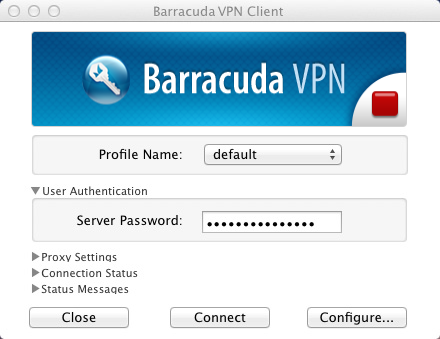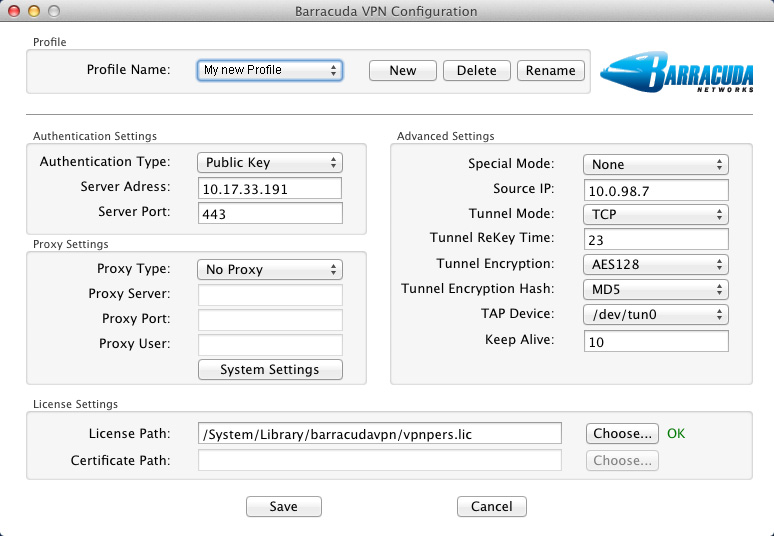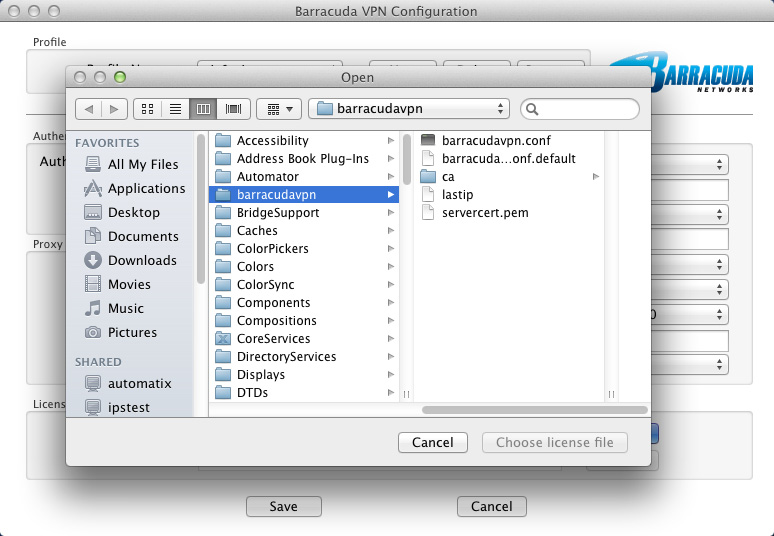After installing the Barracuda VPN Client for macOS, configure your VPN connection settings. In the Barracuda VPN Client, your VPN connection settings are saved in a VPN profile. You can create a new VPN profile or edit an existing VPN profile.
Configure the VPN Client
In the Barracuda VPN Configuration window, you can specify the settings for a new VPN profile or edit the settings for an existing VPN profile. In the Profile section, you can delete or rename the profile by clicking Delete or Rename.
Launch the Barracuda VPN Client. You can access it through the Finder and the Launchpad. It resides in the Applications folder.

To create a new VPN profile, select New from the Profile Name drop-down list. To edit an existing VPN profile, select it from the Profile Name list and click Configure.
Enter a name for your new profile and click OK.

The Barracuda VPN Configuration window opens.
Select the Authentication Type from the drop-down list.
In the Server Address field, enter the IP address or host name of the VPN server. You can also enter a comma-delimited list of VPN servers.
Enter the VPN Server Port.
If a proxy is required, configure it in the Proxy Settings section. You can specify the following settings:
- Proxy Type – Select one of the following types:
- No Proxy
- HTTP (disables all tunnel modes except TCP)
- Socks4 (disables all tunnel modes except TCP)
- Socks5
- Proxy Server – The IP address or host name of the proxy server.
- Proxy Port – The proxy server port. Examples for common port numbers are 3128 or 8080. Your network administrator can provide you with the correct port number.
Proxy User – The username to authenticate at the proxy server.
- Proxy Type – Select one of the following types:
In the License Settings section, import your licenses and certificates.
- To import a license, click Choose next to the License Path field and select the required license.

- To import a certificate, click Choose next to the Certificate Path field and select the required certificate.
Click Save.
Your VPN profile configuration is saved to a plain text ASCII file: /System/Library/barracudavpn/barracudavpn.conf
Configure Advanced Settings
In the Advanced Settings section, you can specify more detailed settings for the Barracuda VPN Client. In this section, not all settings are mandatory. Some settings depend on the proxy type for the VPN profile.
In this section, you can specify the following settings:
- Special Mode – To deactivate tunnel probing, select Silent. For normal operation, select None.
This setting is dependent on the VPN server. - Source IP – The IP address that is assigned to the client for the TAP device.
This setting is dependent on the VPN server. Tunnel Mode – The protocol for the VPN tunnel. You can select TCP, UDP, or Hybrid.
Tunnel Encryption Hash – The hash algorithm to be used. You can select MD5 or SHA1.
The selected option must be supported by the VPN server.- Tunnel Encryption – The tunnel encryption method. You can select AES128, AES256, CAST, BlowFish, 3DES, or DES.
The selected option must be supported by the VPN server. - TAP Device – The TAP device that is used for the VPN tunnel. In most cases, the required TAP device is /dev/tun0.
- Keep Alive – The interval in seconds to send keepalive signals.
After configuring your VPN profiles, you can start using your VPN connections. Continue with How to Establish a VPN Connection Using Barracuda VPN Client for macOS.
